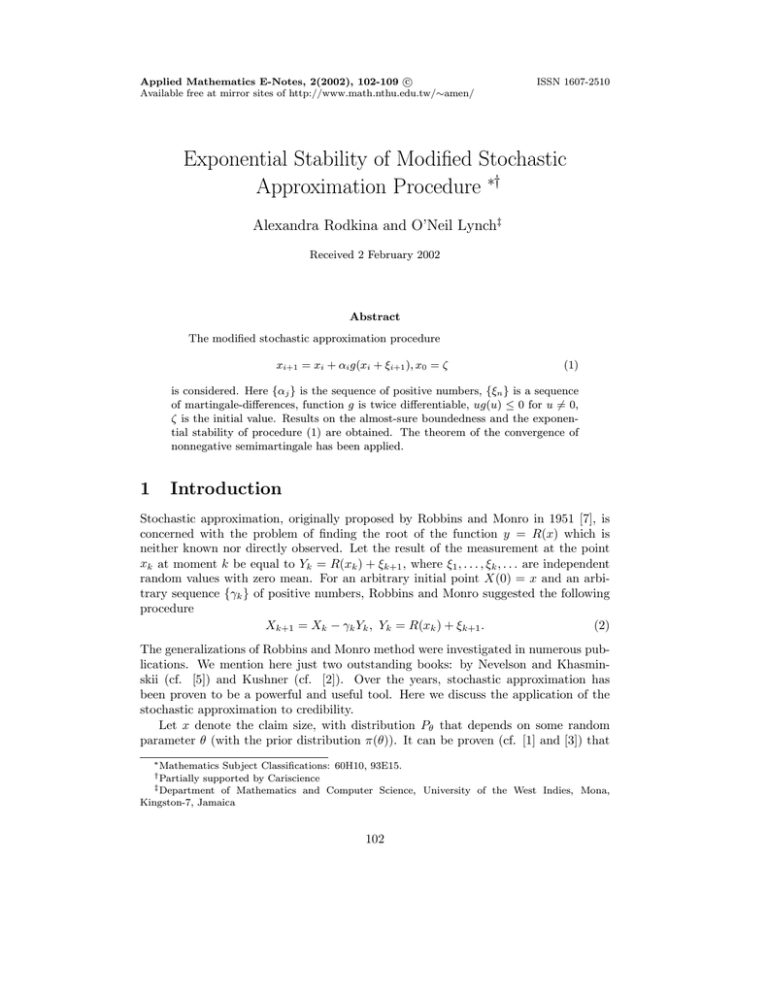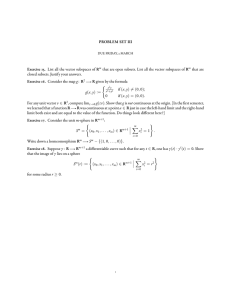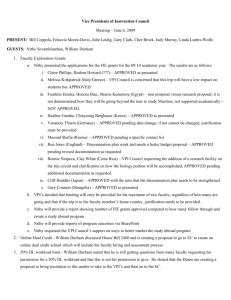Document 10677169
advertisement

Applied Mathematics E-Notes, 2(2002), 102-109 c
Available free at mirror sites of http://www.math.nthu.edu.tw/∼amen/
ISSN 1607-2510
Exponential Stability of Modified Stochastic
Approximation Procedure ∗†
Alexandra Rodkina and O’Neil Lynch‡
Received 2 February 2002
Abstract
The modified stochastic approximation procedure
xi+1 = xi + αi g(xi + ξi+1 ), x0 = ζ
(1)
is considered. Here {αj } is the sequence of positive numbers, {ξn } is a sequence
of martingale-differences, function g is twice differentiable, ug(u) ≤ 0 for u = 0,
ζ is the initial value. Results on the almost-sure boundedness and the exponential stability of procedure (1) are obtained. The theorem of the convergence of
nonnegative semimartingale has been applied.
1
Introduction
Stochastic approximation, originally proposed by Robbins and Monro in 1951 [7], is
concerned with the problem of finding the root of the function y = R(x) which is
neither known nor directly observed. Let the result of the measurement at the point
xk at moment k be equal to Yk = R(xk ) + ξk+1 , where ξ1 , . . . , ξk , . . . are independent
random values with zero mean. For an arbitrary initial point X(0) = x and an arbitrary sequence {γk } of positive numbers, Robbins and Monro suggested the following
procedure
Xk+1 = Xk − γk Yk , Yk = R(xk ) + ξk+1 .
(2)
The generalizations of Robbins and Monro method were investigated in numerous publications. We mention here just two outstanding books: by Nevelson and Khasminskii (cf. [5]) and Kushner (cf. [2]). Over the years, stochastic approximation has
been proven to be a powerful and useful tool. Here we discuss the application of the
stochastic approximation to credibility.
Let x denote the claim size, with distribution Pθ that depends on some random
parameter θ (with the prior distribution π(θ)). It can be proven (cf. [1] and [3]) that
∗ Mathematics
Subject Classifications: 60H10, 93E15.
supported by Cariscience
‡ Department of Mathematics and Computer Science, University of the West Indies, Mona,
Kingston-7, Jamaica
† Partially
102
A. Rodkina and O. Lynch
103
for some distributions P and π (the Normal/Normal, the Poisson/Gamma, etc.) the
tradition credibility formula
µ̂n = (1 − αn )m + αn x̄n ,
(3)
takes place. Here µ̂n is an estimation of the fair premium, m is the collective fair
premium, x̄n is the mean of n years of individual experience x1 , x2 , . . . , xn . It is not
difficult to show that (3) can be rewritten as a stochastic recursion of the type (2). The
latter is particularly suited for the sequential evaluation of the fair premium. However
in some situations (see [3])) tradition credibility formula fails and the stochastic approximation gives rise to some kind of quasi-credibility. In this case, instead of the
stochastic approximation procedure (2), we need to consider the following modified
procedure
xi+1 = xi + αi g(xi + ξi+1 ), x0 = ζ.
(4)
In this paper we investigate the exponential stability of procedure (4), where the
errors of the observation ξi are martingale-differences, the function g is twice differentiable and ug(u) ≤ 0 for u = 0. The theorem of the convergence of nonnegative
semimartingale will be needed (cf. [6]).
2
Definitions and Auxiliary Lemmas
Let the probability space (Ω, F, P ) with filtration F = {Fn }n=1,2,... be given. Let the
stochastic sequence {mn } be an Fn -martingale with m0 = 0. We put ξn = mn − mn−1
for n ≥ 1 where ξ0 = 0. Then the stochastic sequence {ξn } is an Fn -martingaledifference. For detailed definitions and facts of random processes, the reader can see
e.g. [4]. We present below two necessary lemmas which will be used in this paper.
LEMMA 1. Let {ξn } be an Fn -martingale-difference. Then there exists an Fn martingale-difference {µn } and a positive Fn−1 -measurable stochastic sequence {ηn }
such that for every n = 1, 2, . . . ,
ξn2 = µn + ηn
a.s.
(5)
where
LEMMA 2. Let Zn = Z0 +A1n −A2n + Mn be a non-negative semimartingale,
1
2
1
Mn is a martingale,
A
,
A
are
a.s.
non-decreasing
processes.
Then
ω
::
A
<
∞
⊆
n
n
∞
2
{Z →} ∩ A∞ < ∞ a.s.
Here {Z →} denotes the set of all ω ∈ Ω for which Z∞ = lim Zt exists and is finite.
t→∞
The notation a.s. means almost-surely.
3
Boundedness of Solution
Let the function g be twice differentiable and for any u ∈ ,
ug(u) ≤ 0,
u = 0,
g 2 (u) ≤ K1 u2 ,
(6)
(7)
104
Modified Stochastic Procedure
|g (u)| ≤ K,
(8)
where K1 , K > 0 are nonrandom numbers. Let {ξn } be a sequence of Fn -martingaledifferences with ξ0 = 0 and decomposition (5) takes place. Let {αj } be a sequence of
positive numbers such that a.s.
∞
[
αj = ∞,
(9)
j=0
∞
[
α2j < ∞,
(10)
αj ηj+1 < ∞.
(11)
j=0
∞
[
j=0
THEOREM 1. Let conditions (6)-(11) be fulfilled, then the solution xi to equation
(4) has the following properties:
sup x2i < ∞ and
0<i<∞
lim inf xi = 0 a.s.
i→∞
PROOF. Applying Taylor’s expansion to g(xi + ξi+1 ) we have
x2i+1 − x2i
= (xi + αi g(xi + ξi+1 ))2 − x2i
ξ2
≤ 2αi xi g(xi ) + g (xi )ξi+1 + g (u) i+1 + αi2 K1 (xi + ξi+1 )2 ,
2
where u lies between xi and ξi+1 . From above and using the decomposition of ξi2 (see
Lemma 1 and (5)) we have
x2i+1 − x2i
≤ 2αi xi g(xi ) + (Kαi |xi | + 2K1 αi2 )ηi+1 + 2K1 α2i x2i + 2αi xi g (xi )ξi+1
+(Kαi |xi | + 2K1 αi2 )µi+1 .
Let ∆mi = 2αi xi g (xi )ξi+1 + (Kαi |xi | + 2K1 αi2 )µi+1 , which is a martingale-difference.
Applying the estimation |xi | ≤ 1 + x2i , we get
x2i+1 − x2i ≤ 2αi xi g(xi ) + (Kαi + 2K1 α2i )ηi+1 + (Kαi ηi+1 + 2K1 α2i )x2i + ∆mi , (12)
and then
x2i+1 ≤ 2αi xi g(xi ) + (1 + βi )x2i + (Kαi + 2K1 α2i )ηi+1 + ∆mi ,
(13)
where βi = Kαi ηi+1 + 2K1 α2i . Note that (10)-(11) imply
i
\
(1 + βj ) < M
j=1
for some nonrandom M > 0 and every i = 1, 2, . . . Letting
xi+1 =
i
\
(1 + βj )1/2 yi+1
j=1
(14)
A. Rodkina and O. Lynch
105
and substituting it in (13) we get
i
\
(1 +
2
βj )(yi+1
−
j=1
yi2 )
≤ 2αi
i−1
\
1/2
(1 + βj )
yi g
j=1
i−1
\
(1 + βj )
1/2
j=1
yi
+(Kαi + 2K1 αi2 )ηi+1 + ∆mi .
Let
i
\
(1 + βj )−1 ∆mi = ∆m1i ,
j=1
which is a martingale-difference, therefore
2
− yi2
yi+1
≤ 2
i
\
(1 + βj )−1 αi
j=1
i
\
+
i−1
\
(1 + βj )1/2 yi g
j=1
i−1
\
(1 + βj )1/2 yi
j=1
(1 + βj )−1 (Kαi + 2K1 α2i )ηi+1 + ∆m1i .
(15)
j=1
Taking the sum of (15) from i = 0 to i = n − 1, we have
n−1
[
i=0
2
yi+1
−
n−1
[
yi2
i=0
≤ 2
n−1
[
i
\
(1 + βj )−1 αi
i=0 j=1
+
n−1
[
i
\
i−1
\
(1 + βj )1/2 yi g
j=1
i−1
\
(1 + βj )1/2 yi
j=1
(1 + βj )−1 (Kαi + 2K1 αi2 )ηi+1 +
i=0 j=1
n−1
[
∆m1i .
i=0
Therefore
yn2 ≤ Un = y02 + A1n − A2n + m1n ,
where
A1n =
n−1
[
i
\
(16)
(1 + βj )−1 (Kαi + 2K1 αi2 )ηi+1
i=0 j=1
and
A2n
= −2
n−1
[
i
\
i=0 j=1
(1 + βj )
−1
αi
i−1
\
(1 + βj )
j=1
1/2
yi g
i−1
\
1/2
(1 + βj )
j=1
yi .
It should be noted that A1n and A2n are increasing processes a.s., m1n is a martingale,
Un is nonnegative semimartingale and P {A1∞ < ∞} = 1 due to the convergence of
series in (10) and (11). Applying Lemma 2, that is
{A1∞ < ∞} ⊂ {Ui →} ∩ {A2∞ < ∞},
we have
P {Ui →} = 1.
106
Modified Stochastic Procedure
This implies that there exists some a.s. finite random value H = H(ω) such that
P { sup Ui ≤ H} = 1. Then P { sup yi2 ≤ H} = 1 and the first part of the theorem
0<i<∞
0<i<∞
is proved.
Suppose now that P {lim inf yi2 > 0} = p0 > 0. Then there exist random variables
i→∞
ζ0 = ζ0 (ω) > 0 and N0 = N0 (ω) > 0 such that P (Ω0 ) = p0 , where Ω0 = {ω : yi2 >
i
i
T
T
(1 + βj )1/2 > 1, we have yi2
(1 + βj )1/2 > ζ0 (ω)/2 for
ζ0 (ω)/2 for i > N0 }. Since
j=1
j=1
i > N0 and ω ∈ Ω0 . Due to the continuity and negativity (for u = 0) of the function
φ(u) = ug(u) we can find k0 = k0 (ω) and N1 = N1 (ω) ≥ N0 (ω) such that
\
i
1/2
(1 + βj ) yi > k0 (ω)
−φ
j=1
for ω ∈ Ω0 and i > N1 . Then
−2
= −2
≥ −2
n−1
[
αi
i=0
(1 + βj )1/2 yi (ω)g
j=1
N[
1 −1
i=0
n−1
[
i=N1
≥ 2k0 (ω)
i
\
−2
\
i
(1 + βj )1/2 yi (ω)
j=1
n−1
[
i=N1
\
i
αi φ
(1 + βj )1/2 yi (ω)
j=1
n−1
[
i=N1
αi → ∞
as n → ∞. Hence P {A2∞ = ∞} ≥ p0 > 0 which contradicts (16) and conditions (10)(11). Then P {lim inf yi2 > 0} = 0 and from (14) we have: P {lim inf x2i ≤ M lim inf yi2 =
i→∞
i→∞
i→∞
0} = 1. The theorem is completely proved.
4
Exponential Stability
In addition to the conditions from the previous section let two more conditions be
fulfilled
H1 |x| ≤ |g(x)| ,
(17)
∞
[
i=0
αi ηi+1
i
\
(1 − 2αj H1 )−1 < ∞ a.s.,
(18)
j=1
where H1 > 0 is some constant and ηi+1 → 0 when i → ∞.
REMARK 1. Let H1 |x| ≤ |g(x)| and xg(x) < 0 for all x ∈
following is correct: if x > 0, then
−xg(x) = x|g(x)| ≥ |x|H1 |x| = H1 x2 ;
and x = 0. The
A. Rodkina and O. Lynch
107
and if x < 0, then
−xg(x) = |x||g(x)| ≥ |x|H1 |x| = H1 x2 .
Therefore
xg(x) ≤ −H1 x2 .
(19)
THEOREM 2. Let conditions (6)-(11) and (17)-(18) be fulfilled. Then for any
κ > 0,
%
&
n
[
exp (1 − κ)2H1
αi x2n → 0
i=0
a.s. where xn is a solution of equation (4).
PROOF. Substituting (19) in (12) we get
x2i+1 − x2i ≤ −(2αi H1 − Kαi ηi+1 − 2K1 α2i )x2i + (Kαi + 2K1 α2i )ηi+1 + ∆mi .
(20)
Let
τi = 2αi H1 − Kαi ηi+1 − 2K1 αi2 .
Due to the positivity of K1 , K and ηi+1 from condition (18) we have
i
∞
[
\
2
(Kαi − 2K1 αi )ηi+1
(1 − 2αj H1 + 2K1 αj2 + Kαj ηj+1 )−1
i=0
≤ K
j=0
∞
[
αi ηi+1
i=0
i
\
j=0
(1 − 2αj H1 )−1 < ∞.
(21)
From (20) we get
x2i+1 ≤ (1 − τi )x2i + (Kαi + 2K1 α2i )ηi+1 + ∆mi .
Let
i−1
\
zi2 =
(22)
(1 − τj )−1 x2i
j=1
which implies that
x2i =
i−1
\
(1 − τj )zi2 .
j=1
Substituting it in (22) we get,
i
\
2
(1 − τj )zi+1
≤ (1 − τi )
j=1
and
2
− zi2 ≤
zi+1
i
\
i−1
\
(1 − τj )zi2 + (Kαj + 2K1 αj2 )ηj+1 + ∆mi
j=1
(1 − τj )−1 (Kαj + 2K1 αi j 2 )ηj+1 + ∆m1i ,
j=1
(23)
108
Modified Stochastic Procedure
i
T
where ∆m1i =
j=1
obtain
(1 − τj )−1 ∆mi . Taking the sum of (23) from i = 0 to i = n − 1, we
zn2 ≤ z02 +
n−1
[
i
\
(1 − τj )−1 (Kαj + 2K1 αj2 )ηj+1 + m1n .
i=0 j=1
Applying (21) and using the same arguments as in Theorem 1 we obtain that there
exists some a.s. finite random value H = H(ω) such that P { sup zi2 ≤ H} = 1. As
0<i<∞
αi , ηi+1 → 0 when i → ∞ for any ε > 0 there exists the random integer N = N (ω) > 0
such that for any j ≥ N
2K1 αj + Kηj+1 < 2H1 ε.
Then for some H2 > 0
x2i
≤ HH2
i
\
j=N
(1 − 2H1 (1 − ε)αj ) = HH2 exp{
i
[
ln 1 − 2H1 (1 − ε)αj }
j=N
≤ HH2 exp{−2H1
i
[
j=N
(1 − ε)αj }.
(24)
If we take some κ > 0 and ε < κ/2, then from (24) we obtain that P { lim exp{(1 −
i→∞
κ)2H1
i
S
j=N
αj }x2i
= 0} = 1. The proof is complete.
In the following example we investigate the fulfillment of the condition (18). We
consider two different cases for αi , and ηi .
EXAMPLE. a) Let αi = 1i and ηi ≤ C(ω)/iε+2H1 for some ε > 0 and a.s. finite
random variable C(ω) > 0. Then
i
\
j=N
and a.s.
(1 − 2H1 αj )−1 =
∞
[
αi ηi+1
i=1
i
\
i
\
−
e− ln(1−2H1 αj ) = e
j=N
(1 − 2αj H1 )−1 ≤ K2
j=1
i
S
∞
[
1
i=1
ln(1−2H1 αj )
≤ K1 i2H1 ,
j=N
i
i2H1
C(ω)
< ∞,
iε+2H1
where K1 and K2 are some constants.
b) Let αi = (i ln i)−1 and ηi ≤ C(ω)/iε+2H1 for some ε > 0 and a.s. finite random
variable C(ω) > 0. Then
i
\
j=N
(1 − 2H1 αj )−1 ≤ K1 ln2H1 i,
and a.s.
∞
[
i=0
αi ηi+1
∞
i
\
[
C(ω)
1
(1 − 2αi H1 )−1 ≤ K2
ln2H1 i ε+2H1 < ∞.
i ln i
i
i=1
i=1
A. Rodkina and O. Lynch
109
References
[1] T. Herzog, Introduction to Credibility Theory, ACTEX Publications, Inc., 1996.
[2] H. J. Kushner, Stochastic Stability and Control, Academic Press, 1967.
[3] Z. M. Landesman and U. E. Makov, Exponential Dispersion Models and Credibility,
Scand. Actuarial J., 1(1998), 89-96.
[4] R. Sh. Liptser and A. N. Shiryayev, Theory of Martingales, Kluwer Academic,
Dortrecht, 1989.
[5] M. Nevelson and R. Khasminskii, Stochastic approximation and recurrent estimates. Providence. AMS., 1972.
[6] A. Rodkina, On Asymptotic Behaviour of solutions of stochastic difference equations, Nonlinear Analysis, 47(2001), 4719-4730.
[7] H. Robbins and S. Monro, A stochastic approximation method. Ann. Math. Stat.
29(1951), 400-407.








